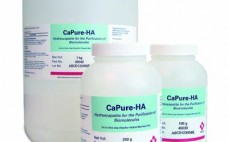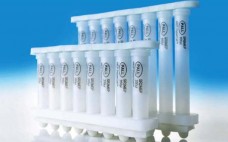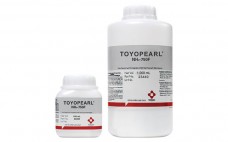Pall’s Cadence™ single-pass tangential flow filtration (SPTFF) technology provides a simple solution for continuous concentration and optimization of Downstream Processing (DSP) steps. It eliminates the conventional TFF recirculation loop and allows product to be concentrated in a single pump pass. The single-pass operation eliminates any mixing or foaming issues and exposes the product to low shear; thus, it is optimal for the processing of fragile and shear-sensitive molecules as well. The single-pass feed flow rates are lower compared to conventional…
Downstream
CaPure-HA™: DoE Optimization of Elution Conditions
Design of Experiments (DoE), also called experimental design, is a statistical approach to process development that has gained wide acceptance in the biopharmaceutical industry. DoE is used to reduce development costs by speeding up the design process and to optimize the parameters of a particular step in the manufacturing process. The data presented here demonstrate the optimization of the CaPure-HA elution using a DoE approach.
Pressure Interruptions (Stop/Start) During Virus Filtration: Assuring Safety Using Robust Process Technology and An Appropriate Risk Mitigation Strategy
Following publications discussing the impact of pressure interruptions on the retention levels of virus filters, an increased focus is being placed on filter users’ own risk mitigation strategies. Users are increasingly requesting technical guidance and support with viral validation from filtration experts, as part of their overall product support package. This guidance document provides a high level of assurance to filter users by demonstrating how combining robust virus clearance technology with the use of standard operating procedures can assure a…
Sterile Vent Filtration on Ozonated Water Tanks
With many pharmaceutical processes requiring large volumes of water, it is critical that any pharmaceutical-grade water used is protected from particulate or microorganism contamination, in order to ensure that process operations do not become inadvertently contaminated. Several approaches can be used to ensure that water remains free from contamination, including the storage of purified water or WFI (Water For Injection) at a minimum temperature of 80°C to discourage microbial growth in the storage system. Another approach is to add ozone,…
Computer-Aided Assay Development for Charge Heterogeneity Analysis by iCE
Unlike chemically synthesized drugs, protein therapeutics are a dynamic heterogeneous mix of active compounds. Due to their complexity, analytical techniques like isoelectric focusing have become indispensable tools in evaluating biologic preparations. The resulting surge in charge isoform analysis has led to major advances in instrumentation, such as Imaged Capillary Electrophoresis (iCE™)2 . However, to obtain the full benefit from improved instrumentation requires the coinciding development of robust assays. The goal of this note is to promote the successful application of…
Use of ScreenExpert RoboColumns for High Throughput Study of Loading Conditions on HyperCel™ STAR AX and MEP HyperCel Sorbents for MAb Purification in Flow-Through Mode
The use of HyperCel STAR AX and MEP HyperCel sorbents for MAb polishing provides efficient contaminant removal. A study to screen loading conditions for MAb purification in flow-through mode on MEP HyperCel and HyperCel STAR AX sorbents was conducted using 200 ÎĽL ScreenExpert RoboColumns. The study demonstrates the suitability of ScreenExpert RoboColumns for scale down evaluation of chromatographic parameters, and the good consistency with data obtained on 1 mL PRC prepacked columns. ScreenExpert RoboColumns allow loading of high sample volume…
Implementation of Mustang® Q Membrane Chromatography as a Polishing Step (Residual DNA Removal) in Monoclonal IgG1 Production from CHO Cell Culture
In collaboration with ProBioGen AG, Berlin, Germany, Mustang Q membrane chromatography was evaluated as a polishing step following protein A affinity and cation exchange chromatography to remove residual host cell DNA during a Monoclonal antibody (MAb) purification process at 250 L cell culture production-scale. Data indicated efficient DNA clearance by the Mustang Q membrane chromatography step during the process (96%). Additionally, contribution of the Mustang Q membrane chromatography polishing step to HCP removal was shown. Based on a virus-spiking scale-down…
CaPure-HA Resin for Aggregate Removal from Monoclonal Antibodies
Scientists in the field of process chromatography methods development are constantly on the lookout for better and more selective ways to remove aggregates and other process related impurities from monoclonal antibody monomer. The data presented in the following paper demonstrates the capabilities of CaPure-HA to remove degradation products, dimer, and higher order aggregates from the monomer of a protein A purified IgG1 monoclonal antibody.
Evaluation of HCP and DNA Clearance with NatriFlo™ HD-Q Membrane Adsorbers at Lab to Process Scales
NatriFlo™ HD-Q chromatography from Natrix Separations introduces reliable and reproducible Q polish performance that combines resin binding capacity with adsorber speed to achieve a new level of process flexibility. Gallus Biopharmaceuticals (a St. Louis based CMO) evaluated NatriFlo™ HD-Q membrane columns as an anion exchange polishing step with the objective of assessing NatriFlo’s ability to (1) reduce process-derived impurities to achieve target product profile; (2) maintain process robustness to process changes; and (3) achieve reliable scalability from lab to production.…
TOYOPEARL NH2-750F Aggregate Removal from Monoclonal Antibodies
The drive to reduce the manufacturing costs for biological therapeutics have increased the demands placed on downstream unit operations to the point where a single processing step is expected to accomplish a multitude of purification objectives. Where anion exchange resins have traditionally been used to remove DNA, endotoxin, and as a viral clearance step in the purification of monoclonal antibodies (mAbs), new ligand chemistries make it possible for anion exchange chromatography to do more. In the following paper, TOYOPEARL NH2-750F,…










